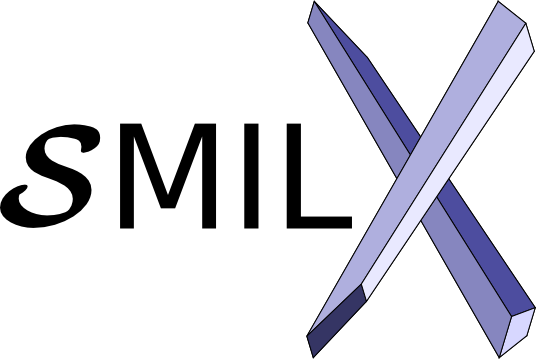 sMILX
Help
sMILX
Help
Models
This page describes the
model/surface processing capabilities of sMILX. A model in sMILX is
defined as a polydata structure that can contain meshes/surfaces (with
or without scalars) or vector/tensor fields or streamlines etc.
The options are mostly available through the right click menu and are
described below:
- Compare - Click on this for every model that your want to compute
the Hausdorff distance for or to overlay together.
- Link Windows - Link all the windows so that the camera of the
view is always oriented exactly the same in real space in all windows
of the tab.
- Switch to - Switch to window given in the open windows list.
- Import
View from - Import the 'actors' (i.e. the display elements, such as the
slice or surface or field) to this current display. This can be used
for overlaying surfaces on slices etc. Note that the imported actor
will be 'in front' of the current actors, useful to know when the
actors exactly overlap and one cannot be seen, i.e. the order makes a
difference when the objects are in exactly the same space.
- Generate - Generate various displays from the underlying model
data:
- Vertices - put glyphs for every point in the model.
- Normals - create a array in the model that contains vector data
that represents the point normals.
- Vector Field - from the vector data in the model, create arrows
with the size and magnitude given by the length.
- Tensor Field - from the tensor data in the model, create
ellipsoids that represents the tensors.
- Hedgehog - from the vector data in the model, create lines with
the size and magnitude given by the length.
- Point Model - for every point in the model, create a low
resolution sphere (auto scaled) to show each point.
- Vertex Labels - create a model where each point is labelled by
their point ID. The label text replaces the vertex glyphs.
- Point IDs - Set the scalar field of the model to that of the
point ID value.
- K-Means Points Clustering - Cluster the model points (by
position) by the given number of clusters.
- Cap
Boundaries - cover the 'ends' of a surface by computing the boundry
edges of the surface and creating triangles to cover them.
- Label Unconnected Regions - Colour each unconnected region.
- Operations - process the geometry and topology of the model:
- Clean - remove redundant points and cells from the model.
- Triangulate - convert the polygons representing the model to
triangles.
- Decimate - Surface simpliciation. Reduce the number of points
in the model using a very simply algorithm.
- Quadric Decimate - Surface simpliciation. Reduce the number of
points in the model using quadric errors. Recommended.
- Quadric Clustering - Surface simpliciation. Reduce the number
of points in the model using quadric clustering algorithm.
- Smooth - mesh fairing by using the Laplace-Beltrami operator.
- Smooth Windowed Sinc - Optimal mesh fairing using the Taubin
filtering algorithm. Recommended.
- Mean curvature - show the mean curvature of the model as a
scalar field.
- Transforms - Transform the model in vairous ways:
- Transform (via File) - Use an ITK transform file to apply
either an affine or rigid transform to the model.
- Match Info to - Match the centroid and centroid scale
(optional) of the current model to the model provided.
- Register (ICP) to - Apply iterative closest points registration
between the current model and the provided model.
- Register (Landmark) to - Apply the landmark transform
registration between
the current model and the provided model. Note that this requires the
models have correspondence and the same number of points.
- Voxelise - Convert a surface into a voxel representation so
that it can be saved as a binary image.
- Scalar Operations - Applu operations to the scalar field on the
model:
- Rename Scalars - rename the array of the current active
scalars. This is used for the scalar bar etc. and sometimes used by
other programs automatically to generate figures.
- Clip
mesh based on scalar threshold - remove the parts of the mesh that
doesn't not coincide with a scalar field value threshold, say removing
all parts of a mesh with a scalar value of less than 1.0.
- Scalar Gradient - compute the gradient of the scalar field, a
vector field array is generated and stored. Use Generate->Vector
Field to see it.
- Load Scalars... - Load a scalar field from another model, must
have the same number of points as the current model.
- Output Scalars as CSV - output the scalar field of the current
model to a field with values separated by commas and all present in the
first row.
- Undo/Redo Last Operation - Rollback the last change
- Model Information - Print the number of points etc. to the log
window
- Flip Model - flip the model depending on the axis specified.
- Change
Mesh Colour/Transparency - Change the model colour and transparency.
Transparency is controlled via the alpha channel and this feature only
works for models with no scalars.
- Phong Shading - Improve the cell interpolation by utilising the
normals. Results in a smoother polygonal model.
- Scalar Bar - Show the scalar bar for the scalar field, this
ensures that the scalar field display range is correct. The scalar bar
is adjustable.
- Contouring - contour a polygonal surface:
- Select points within contour - Compute the signed distance map
of the contour, inside is negative.
 sMILX
Help
sMILX
Help sMILX
Help
sMILX
Help